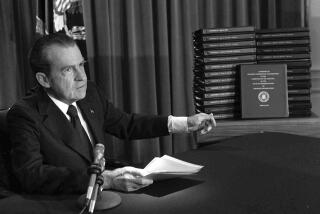Spending Machine Is Stuck in High Gear : Military: Budgets sound more modest than they really are. It makes little sense to ‘protect’ defense for another two years.
- Share via
For the past four decades this nation has spent an average of $270 billion, in today’s dollars, to deal with the threat of Soviet communist expansionism. In 1989 the Soviet empire collapsed and in 1991, the Soviet Union itself dissolved and the Soviet leadership repudiated communism.
One would think that in 1992, the Pentagon would be requesting and receiving far less than $270 billion from the Democratic-controlled Congress. In spite of the rapidly increasing deficit and the large number of unmet social needs, Congress gave the military every nickel it requested for 1992--more than $290 billion. Moreover, the Pentagon plans to continue spending at the Cold War average through the middle of this decade. According to this logic, the March of Dimes would still be requesting large sums of money to fight polio even after the development of the Salk vaccine.
How did this happen and what can be done about it? There are two reasons why the nation is still spending so much on the military. The Pentagon is using such misleading points of reference to measure its spending levels that its budget appears to reflect the “new world order.” Pentagon spokesmen routinely note that between 1985 and 1992, military spending declined by 25%. What they fail to note is that in 1985 the defense budget reached a post-World War II high of more than $360 billion, higher than the peak year of the Vietnam War, and double what the Department of Defense spent in 1980.
The large increases in defense spending in the 1980s were ostensibly to make up for the decade of neglect in the 1970s when we spent “only” $250 billion a year. Similarly the secretary of defense noted ad nauseam, while Congress was considering the 1992 budget, that his current five-year plan will bring defense spending down to 3.7% of GNP, its lowest level since before Pearl Harbor. While this statement is true and even politically persuasive, it says more about our nation’s economic well-being than what we should be spending on defense. In 1940, the defense budget was well below $100 billion, not almost $300 billion.
A second reason for the unrealistically high levels of defense spending in 1992 is the ill-conceived Budget Enforcement Act of 1990. This legislation, agreed to at last year’s budget summit as the nation was preparing to go to war in the Persian Gulf, prevents Congress from transferring funds from defense to social programs until 1994. Any cuts below the stipulated levels can only go toward deficit reduction, an unlikely prospect in the midst of a recession. Since this legislation was passed before the collapse of the Soviet Union and Soviet communism, and since the war in the Gulf was concluded so rapidly and so inexpensively, it makes little sense to “protect” defense for another two years.
It is probably too late to undo the 1992 defense budget, but Congress should reduce defense spending for 1993 through 1995 at least $50 billion below projected levels. This would still leave defense with more than $800 billion for that period, or just about $270 billion a year. Certainly the Cold War average should be enough to handle a world without the threat of Soviet military power.
More to Read
Get the L.A. Times Politics newsletter
Deeply reported insights into legislation, politics and policy from Sacramento, Washington and beyond. In your inbox twice per week.
You may occasionally receive promotional content from the Los Angeles Times.








